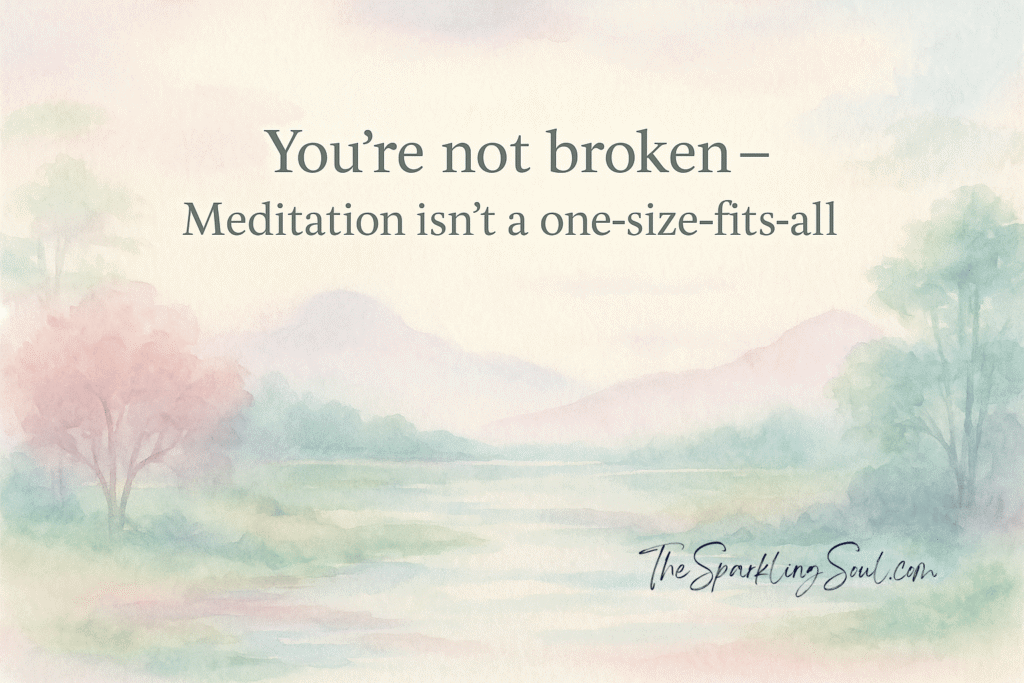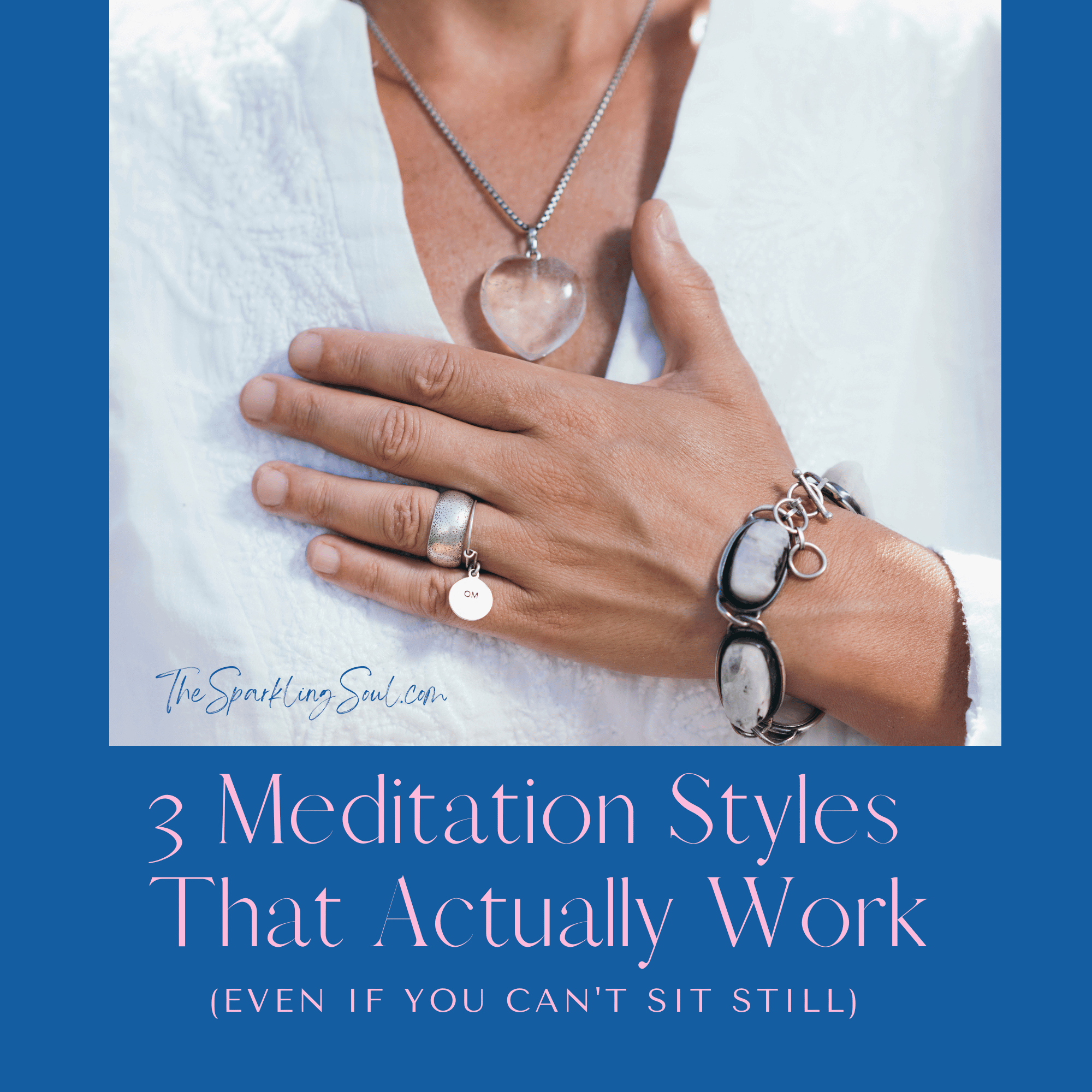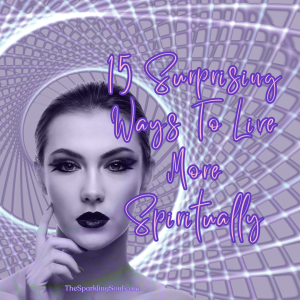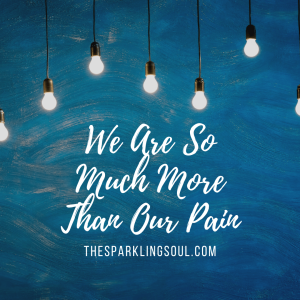(Even If You Can’t Sit Still)
Have you ever tried to meditate and felt like your mind was running a marathon while your body was supposed to be sitting in lotus pose? You’re definitely not alone. Here are some meditation ideas for beginners (and for everyone else, too) that I think you’ll find helpful.

After many years of exploring spiritual practices, I’ve met countless people who believe they “can’t meditate” because they can’t sit still and empty their minds. Here’s what I wish I could tell every single one of them: You’re not broken, and meditation isn’t a one-size-fits-all practice.
The truth is, the image of meditation we see everywhere—someone sitting cross-legged in perfect stillness—represents just one path to inner peace. In reality, there are as many ways to meditate as there are people seeking that small, still voice within.
If traditional meditation has left you feeling frustrated or like you’re “doing it wrong,” this post is for you. I’m going to share three meditation styles for beginners that work beautifully for restless minds and busy bodies. By the end, you’ll have practical techniques you can try today, along with the permission to honor your unique way of finding stillness.
Why Traditional Meditation Fails for Most People
Let’s be honest about something: sitting in silence and “emptying your mind” is incredibly difficult, especially in our modern world. Your brain is designed to think—that’s literally its job. When you suddenly ask it to stop, it often rebels by thinking even more.
I spent decades believing that “real” meditation required perfect posture and a completely quiet mind. I would sit there, trying to force my thoughts to stop, or even just trying to “let the thoughts just roll on by,” and instead getting increasingly frustrated with every passing minute. Sound familiar?
The breakthrough came when I realized that meditation isn’t about stopping thoughts—it’s about creating space to hear your inner wisdom above the noise. And for many of us, that space is created through movement, creativity, or gentle focus rather than forced stillness.
Whether you are looking for tips for meditation for beginners, or you are just wanting to add some variety to your meditation practice, I think you’ll like the following suggestions:
Meditation Style #1: Walking Meditation
Walking meditation has been practiced for thousands of years, yet somehow it gets overlooked in our culture’s obsession with seated meditation. This practice is perfect if you find sitting still uncomfortable, anxiety-provoking, or simply impossible.

How to Practice Walking Meditation:
Choose Your Space: You can walk anywhere—around your living room, in your backyard, through a park, or even in a quiet hallway. The location matters less than your intention.
Set Your Pace: Walk slower than normal, but not so slow that you feel unnatural. Find a rhythm that feels both deliberate and comfortable.
Focus Your Attention: Instead of trying to empty your mind, give it something specific to focus on:
- The sensation of your feet touching the ground
- The rhythm of your breath as you walk
- The feeling of air moving across your skin
- The sounds around you without judging them
When Your Mind Wanders: (And it will!) Simply notice where it went, and gently return your attention to your walking. This isn’t failure—it’s exactly what you’re supposed to do.
Why Walking Meditation Works:
Your body gets to move, which satisfies that restless energy, while your mind has a gentle anchor point. The repetitive nature of walking naturally calms the nervous system, making it easier to access that inner stillness you’re seeking. Walking meditation can be a particularly good meditation for beginners, but really, anyone can learn to love this simple but helpful meditation practice.
I often tell people that some of my deepest spiritual insights have come not while sitting on a meditation cushion, but while walking mindfully through my neighborhood. There’s something about the rhythm of movement that opens up channels of awareness.
Meditation Style #2: Creative Meditation
If you’re someone whose hands need to be busy for your mind to settle, creative meditation might be your perfect practice. This is a terrific meditation technique for anyone, especially those looking for meditation techniques for beginners. This includes activities like adult coloring, doodling, knitting, painting, or any repetitive creative activity done with mindful awareness.
How to Practice Creative Meditation:
Choose Your Medium: Pick something simple that doesn’t require complex decision-making. Adult coloring books, zentangle doodling, or simple crafts work beautifully.
Set Your Intention: Before you begin, take a moment to set an intention for your practice. This might be finding peace, gaining clarity on a situation, or simply creating space for whatever wants to emerge.
Focus on the Process: Pay attention to:
- The feeling of the pencil or brush in your hand
- The colors you’re drawn to choose
- The repetitive motions of your hands
- Your breathing as you work
Let Go of Perfection: This isn’t about creating art—it’s about creating space. Your doodles can be stick figures, and your coloring can go outside the lines. The beauty is in the practice, not the outcome. You don’t have to be a skilled artist, nor a seasoned meditator. This is a great practice for beginning artists (or non-artists for that matter!) and for those who are just starting meditating.
Why Creative Meditation Works:
Creative meditation works with your brain’s natural patterns rather than against them. Your creative task gently occupies your conscious mind, allowing your subconscious wisdom to emerge. Many people find this style particularly effective for processing emotions or discovering solutions to problems.
Plus, you end up with something tangible from your practice—whether it’s a colored page, a doodle, or a simple craft. These can become beautiful reminders of your commitment to inner peace.
Meditation Style #3: Breath-Focused Movement
If you are looking for a meditation style for beginners, this one may take a little practice, but it is a deeply satisfying technique. This style combines gentle movement with conscious breathing, making it perfect for people who need some physical engagement but want more structure than walking meditation.
How to Practice Breath-Focused Movement:
Find Your Starting Position: You can stand, sit, or even lie down—whatever feels most comfortable for your body today.
Begin with Simple Movements:
- Gentle arm circles synchronized with your breath
- Swaying side to side like a tree in the breeze
- Simple stretches held for several breaths
- Even something as basic as raising your arms on the inhale and lowering them on the exhale
Create Your Rhythm: Let your breath guide your movement, not the other way around. Inhale as you expand or lift, and exhale as you contract or lower.
Listen to Your Body: This practice is about what feels good and natural for you. There’s no “right” way to move—only the way that serves your body and spirit in this moment.
Why Breath-Focused Movement Works:
This style recognizes the close connection between your body, breath, and spiritual well-being. By honoring this connection, you create a meditation practice that feels integrated and whole rather than forcing your body to be still while your spirit wants to move.
How to Choose Your Perfect Meditation Style
The beautiful thing about having multiple meditation options is that you can experiment and see what resonates with your unique temperament and lifestyle. Here are some questions to help you choose:
Consider walking meditation if:
- You feel anxious or claustrophobic when sitting still
- You do your best thinking while moving
- You have physical discomfort that makes sitting difficult
- You love being in nature or find peace in rhythm and repetition
Consider creative meditation if:
- You’re naturally drawn to arts and crafts
- You find busy hands help calm your mind
- You enjoy having something tangible from your practice
- You’re processing emotions or working through challenges
Consider breath-focused movement if:
- You practice yoga or enjoy gentle stretching
- You want something more structured than walking but more active than sitting
- You’re interested in the mind-body connection
- You find breathwork naturally calming
The truth is, you might find that different styles serve you at different times. If you are new to meditation or looking for meditation techniques that suit beginners, I recommend experimenting with all three to see how each resonates with your body and spirit. Remember, these three are just a few examples; I encourage you to explore other methods such as guided meditation, meditation with music, self-hypnosis, etc., until you find what truly works for you. You may even find that you prefer different approaches for different situations or stages in your life.
Start your meditation practice today
Here’s the most important thing I want you to know: there’s no such thing as perfect meditation. Your mind will wander, you’ll get distracted, and some days the practice will feel easier than others. This is completely normal and expected.
Start small: Begin with just 5-10 minutes of whichever style calls to you most. Consistency matters more than duration.
Be patient with yourself: Remember that meditation is called a “practice” for a reason. You’re not trying to achieve anything specific—you’re simply creating space to connect with your inner wisdom.
Trust your instincts: If a particular style doesn’t feel right for you, try another one. Your spiritual practice should feel nourishing, not forced.
The Real Purpose of Meditation
After decades of spiritual exploration, I’ve learned that meditation isn’t about achieving some perfect state of emptiness or bliss. It’s about creating regular opportunities to listen to that small, still voice within—the voice of your authentic self, your intuition, your connection to something greater. Whether you are new to meditation, or you’ve just always struggled with meditating, these these beginning meditation techniques can help you do that. All it takes is a desire and a little bit of time each day.
Whether you find that voice while walking mindfully through your neighborhood, while coloring with intention, or while moving your body in rhythm with your breath doesn’t matter. What matters is that you’re showing up for yourself, honoring your need for inner peace, and trusting that your spiritual path is uniquely yours.
The world needs your authentic presence, your unique gifts, and the wisdom that comes from your personal spiritual practice. Don’t let anyone—including that critical voice in your own head—tell you that there’s only one “right” way to find your center.
Ready to Begin Your Meditation Journey?
If you’re feeling inspired to explore these meditation styles and develop a sustainable spiritual practice, I’ve created something special for you. My 7-Day Spiritual Reset Guide walks you through different approaches to meditation, along with practices for connecting with your intuition, creating sacred space, and living more authentically.
This free guide includes:
- Detailed instructions for three meditation styles
- Daily practices that take just 10-15 minutes
- Journal prompts for deeper self-discovery
- Simple ways to create sacred space in any home
- Guidance for trusting your unique spiritual path
[Download your free 7-Day Spiritual Reset Guide here →]
Remember: your spiritual journey is uniquely yours. Trust what calls to you, be gentle with yourself, and know that every moment you spend connecting with your inner wisdom is time well spent.
What meditation style are you most excited to try? I’d love to hear about your experience—feel free to share in the comments below or reach out to me directly.



